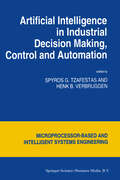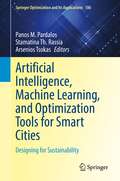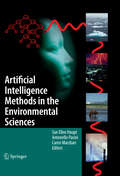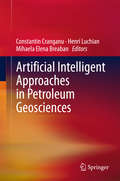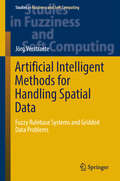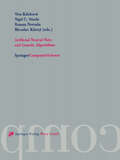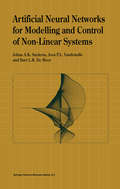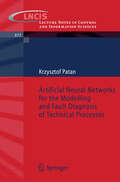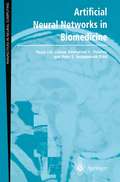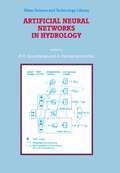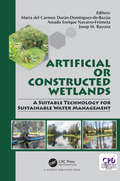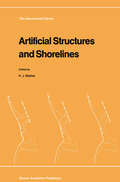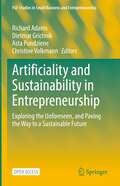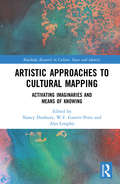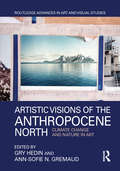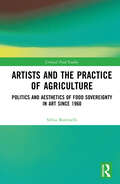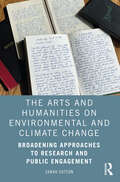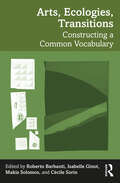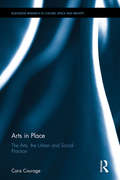- Table View
- List View
Artificial Intelligence in Industrial Decision Making, Control and Automation (Intelligent Systems, Control and Automation: Science and Engineering #14)
by S. G. Tzafestas H. B. VerbruggenThis book is concerned with Artificial Intelligence (AI) concepts and techniques as applied to industrial decision making, control and automation problems. The field of AI has been expanded enormously during the last years due to that solid theoretical and application results have accumulated. During the first stage of AI development most workers in the field were content with illustrations showing ideas at work on simple problems. Later, as the field matured, emphasis was turned to demonstrations that showed the capability of AI techniques to handle problems of practical value. Now, we arrived at the stage where researchers and practitioners are actually building AI systems that face real-world and industrial problems. This volume provides a set of twenty four well-selected contributions that deal with the application of AI to such real-life and industrial problems. These contributions are grouped and presented in five parts as follows: Part 1: General Issues Part 2: Intelligent Systems Part 3: Neural Networks in Modelling, Control and Scheduling Part 4: System Diagnostics Part 5: Industrial Robotic, Manufacturing and Organizational Systems Part 1 involves four chapters providing background material and dealing with general issues such as the conceptual integration of qualitative and quantitative models, the treatment of timing problems at system integration, and the investigation of correct reasoning in interactive man-robot systems.
Artificial Intelligence, Machine Learning, and Optimization Tools for Smart Cities: Designing for Sustainability (Springer Optimization and Its Applications #186)
by Panos M. Pardalos Stamatina Th. Rassia Arsenios TsokasThis volume offers a wealth of interdisciplinary approaches to artificial intelligence, machine learning and optimization tools, which contribute to the optimization of urban features towards forming smart, sustainable, and livable future cities.Special features include:New research on the design of city elements and smart systems with respect to new technologies and scientific thinkingDiscussions on the theoretical background that lead to smart cities for the futureNew technologies and principles of research that can promote ideas of artificial intelligence and machine learning in optimized urban environmentsThe book engages students and researchers in the subjects of artificial intelligence, machine learning, and optimization tools in smart sustainable cities as eminent international experts contribute their research results and thinking in its chapters. Overall, its audience can benefit from a variety of disciplines including, architecture, engineering, physics, mathematics, computer science, and related fields.
Artificial Intelligence Methods in the Environmental Sciences
by Sue Ellen Haupt Antonello Pasini Caren MarzbanHow can environmental scientists and engineers use the increasing amount of available data to enhance our understanding of planet Earth, its systems and processes? This book describes various potential approaches based on artificial intelligence (AI) techniques, including neural networks, decision trees, genetic algorithms and fuzzy logic. Part I contains a series of tutorials describing the methods and the important considerations in applying them. In Part II, many practical examples illustrate the power of these techniques on actual environmental problems. International experts bring to life ways to apply AI to problems in the environmental sciences. While one culture entwines ideas with a thread, another links them with a red line. Thus, a “red thread“ ties the book together, weaving a tapestry that pictures the ‘natural’ data-driven AI methods in the light of the more traditional modeling techniques, and demonstrating the power of these data-based methods.
Artificial Intelligent Approaches in Petroleum Geosciences
by Constantin Cranganu Henri Luchian Mihaela Elena BreabanThis book presents several intelligent approaches for tackling and solving challenging practical problems facing those in the petroleum geosciences and petroleum industry. Written by experienced academics, this book offers state-of-the-art working examples and provides the reader with exposure to the latest developments in the field of intelligent methods applied to oil and gas research, exploration and production. It also analyzes the strengths and weaknesses of each method presented using benchmarking, whilst also emphasizing essential parameters such as robustness, accuracy, speed of convergence, computer time, overlearning and the role of normalization. The intelligent approaches presented include artificial neural networks, fuzzy logic, active learning method, genetic algorithms and support vector machines, amongst others. Integration, handling data of immense size and uncertainty, and dealing with risk management are among crucial issues in petroleum geosciences. The problems we have to solve in this domain are becoming too complex to rely on a single discipline for effective solutions and the costs associated with poor predictions (e.g. dry holes) increase. Therefore, there is a need to establish a new approach aimed at proper integration of disciplines (such as petroleum engineering, geology, geophysics and geochemistry), data fusion, risk reduction and uncertainty management. These intelligent techniques can be used for uncertainty analysis, risk assessment, data fusion and mining, data analysis and interpretation, and knowledge discovery, from diverse data such as 3-D seismic, geological data, well logging, and production data. This book is intended for petroleum scientists, data miners, data scientists and professionals and post-graduate students involved in petroleum industry.
Artificial Intelligent Methods for Handling Spatial Data: Fuzzy Rulebase Systems and Gridded Data Problems (Studies in Fuzziness and Soft Computing #370)
by Jörg VerstraeteThis book provides readers with an insight into the development of a novel method for regridding gridded spatial data, an operation required to perform the map overlay operation and apply map algebra when processing spatial data. It introduces the necessary concepts from spatial data processing and fuzzy rulebase systems and describes the issues experienced when using current regridding algorithms. The main focus of the book is on describing the different modifications needed to make the problem compatible with fuzzy rulebases. It offers a number of examples of out-of-the box thinking to handle aspects such as rulebase construction, defuzzification, spatial data comparison, etc. At first, the emphasis is put on the newly developed method, and additional datasets containing information on the underlying spatial distribution of the data are identified. After this, an artificial intelligent system (in the form of a fuzzy inference system) is constructed using this knowledge and then applied on the input data to perform the regridding. The book offers an example of how an apparently simple problem can pose many different challenges, even when trying to solve it with existing soft computing technologies. The workflow and solutions to solve these challenges are universal and may therefore be broadly applied into other contexts.
Artificial Neural Nets and Genetic Algorithms: Proceedings of the International Conference in Prague, Czech Republic, 2001
by Vera Kurkova Nigel C. Steele Roman Neruda Miroslav KarnyThe first ICANNGA conference, devoted to biologically inspired computational paradigms, Neural Net works and Genetic Algorithms, was held in Innsbruck, Austria, in 1993. The meeting attracted researchers from all over Europe and further afield, who decided that this particular blend of topics should form a theme for a series of biennial conferences. The second meeting, held in Ales, France, in 1995, carried on the tradition set in Innsbruck of a relaxed and stimulating environment for the. exchange of ideas. The series has continued in Norwich, UK, in 1997, and Portoroz, Slovenia, in 1999. The Institute of Computer Science, Czech Academy of Sciences, is pleased to host the fifth conference in Prague. We have chosen the Liechtenstein palace under the Prague Castle as the conference site to enhance the traditionally good atmosphere of the meeting. There is an inspirational genius loci of the historical center of the city, where four hundred years ago a fruitful combination of theoretical and empirical method, through the collaboration of Johannes Kepler and Tycho de Brahe, led to the discovery of the laws of planetary orbits.
Artificial Neural Networks for Modelling and Control of Non-Linear Systems
by Johan A.K. Suykens Joos P.L. Vandewalle B.L. de MoorArtificial neural networks possess several properties that make them particularly attractive for applications to modelling and control of complex non-linear systems. Among these properties are their universal approximation ability, their parallel network structure and the availability of on- and off-line learning methods for the interconnection weights. However, dynamic models that contain neural network architectures might be highly non-linear and difficult to analyse as a result. Artificial Neural Networks for Modelling and Control of Non-Linear Systems investigates the subject from a system theoretical point of view. However the mathematical theory that is required from the reader is limited to matrix calculus, basic analysis, differential equations and basic linear system theory. No preliminary knowledge of neural networks is explicitly required. The book presents both classical and novel network architectures and learning algorithms for modelling and control. Topics include non-linear system identification, neural optimal control, top-down model based neural control design and stability analysis of neural control systems. A major contribution of this book is to introduce NLq Theory as an extension towards modern control theory, in order to analyze and synthesize non-linear systems that contain linear together with static non-linear operators that satisfy a sector condition: neural state space control systems are an example. Moreover, it turns out that NLq Theory is unifying with respect to many problems arising in neural networks, systems and control. Examples show that complex non-linear systems can be modelled and controlled within NLq theory, including mastering chaos. The didactic flavor of this book makes it suitable for use as a text for a course on Neural Networks. In addition, researchers and designers will find many important new techniques, in particular NLq Theory, that have applications in control theory, system theory, circuit theory and Time Series Analysis.
Artificial Neural Networks for the Modelling and Fault Diagnosis of Technical Processes (Lecture Notes in Control and Information Sciences #Vol. 377)
by Krzysztof PatanAn unappealing characteristic of all real-world systems is the fact that they are vulnerable to faults, malfunctions and, more generally, unexpected modes of - haviour. This explains why there is a continuous need for reliable and universal monitoring systems based on suitable and e?ective fault diagnosis strategies. This is especially true for engineering systems,whose complexity is permanently growing due to the inevitable development of modern industry as well as the information and communication technology revolution. Indeed, the design and operation of engineering systems require an increased attention with respect to availability, reliability, safety and fault tolerance. Thus, it is natural that fault diagnosis plays a fundamental role in modern control theory and practice. This is re?ected in plenty of papers on fault diagnosis in many control-oriented c- ferencesand journals.Indeed, a largeamount of knowledgeon model basedfault diagnosis has been accumulated through scienti?c literature since the beginning of the 1970s. As a result, a wide spectrum of fault diagnosis techniques have been developed. A major category of fault diagnosis techniques is the model based one, where an analytical model of the plant to be monitored is assumed to be available.
Artificial Neural Networks in Biomedicine (Perspectives in Neural Computing)
by Paulo J. G. Lisboa Emmanuel C. Ifeachor Piotr S. SzczepaniakFollowing the intense research activIties of the last decade, artificial neural networks have emerged as one of the most promising new technologies for improving the quality of healthcare. Many successful applications of neural networks to biomedical problems have been reported which demonstrate, convincingly, the distinct benefits of neural networks, although many ofthese have only undergone a limited clinical evaluation. Healthcare providers and developers alike have discovered that medicine and healthcare are fertile areas for neural networks: the problems here require expertise and often involve non-trivial pattern recognition tasks - there are genuine difficulties with conventional methods, and data can be plentiful. The intense research activities in medical neural networks, and allied areas of artificial intelligence, have led to a substantial body of knowledge and the introduction of some neural systems into clinical practice. An aim of this book is to provide a coherent framework for some of the most experienced users and developers of medical neural networks in the world to share their knowledge and expertise with readers.
Artificial Neural Networks in Hydrology (Water Science and Technology Library #36)
by R. S. Govindaraju A. R. RaoR. S. GOVINDARAJU and ARAMACHANDRA RAO School of Civil Engineering Purdue University West Lafayette, IN. , USA Background and Motivation The basic notion of artificial neural networks (ANNs), as we understand them today, was perhaps first formalized by McCulloch and Pitts (1943) in their model of an artificial neuron. Research in this field remained somewhat dormant in the early years, perhaps because of the limited capabilities of this method and because there was no clear indication of its potential uses. However, interest in this area picked up momentum in a dramatic fashion with the works of Hopfield (1982) and Rumelhart et al. (1986). Not only did these studies place artificial neural networks on a firmer mathematical footing, but also opened the dOOf to a host of potential applications for this computational tool. Consequently, neural network computing has progressed rapidly along all fronts: theoretical development of different learning algorithms, computing capabilities, and applications to diverse areas from neurophysiology to the stock market. . Initial studies on artificial neural networks were prompted by adesire to have computers mimic human learning. As a result, the jargon associated with the technical literature on this subject is replete with expressions such as excitation and inhibition of neurons, strength of synaptic connections, learning rates, training, and network experience. ANNs have also been referred to as neurocomputers by people who want to preserve this analogy.
Artificial or Constructed Wetlands: A Suitable Technology for Sustainable Water Management
by María-Del-Carmen Durán-Domínguez-De-Bazua Amado Enrique Navarro-Ómeta Josep M. BayonaArtificial or constructed wetlands are an emerging technology particularly for tropical areas with water scarcity. For big cities, the sustainable management of water resources taking into account proper use is always challenging. The book presents case studies illustrating the above. As plants and microorganisms are a fundamental part of the correct functioning of these systems, their contribution to the degradation of the organic matter and to the removal and transformation of the pollutant compounds present in the wastewaters is also a highlight of this book.
Artificial or Constructed Wetlands: A Suitable Technology for Sustainable Water Management
by María del Carmen Durán-Domínguez-de-Bazúa Amado Enrique Navarro-Frómeta Josep M. BayonaArtificial or constructed wetlands are an emerging technology particularly for tropical areas with water scarcity. For big cities, the sustainable management of water resources taking into account proper use is always challenging. The book presents case studies illustrating the above. As plants and microorganisms are a fundamental part of the correct functioning of these systems, their contribution to the degradation of the organic matter and to the removal and transformation of the pollutant compounds present in the wastewaters is also a highlight of this book.
Artificial Structures and Shorelines (GeoJournal Library #10)
by H. Jesse WalkerThis volume is the result of an initiative of the Commission on the Coastal Environment of the International Geographical Union. The initial concept from which the plan has proceeded was presented at the 24th International Geographical Congress in Japan in 1980. AUTHORSHIP AND COVERAGE All of the articles in this volume have been written by specialists familiar with the coastal segment discussed. Nearly all have been prepared by citizens of the country (and, for that matter, even each subregion) considered. In the case of exceptions (e.g. Suriname), the authors have conducted fieldwork on the coast of the country they treat. In order to preserve the "on-the-spot" integrity of the volume, it was decided not to fill in the blanks along the world's coastline with library researched chapters. Thus, coverage is variable. Nearly every coastal country in Europe is represented whereas for Africa and South America there are major gaps. In addition, there are 2 instances of overlap. In the case of England (with a shoreline of nearly 3,000 km) a complementary chapter on Lincolnshire (with a shoreline of only 155 km) is included. The other case is the general article on the Baltic Coast of the USSR which is supported by chapters on Estonia and Lithuania.
Artificiality and Sustainability in Entrepreneurship: Exploring the Unforeseen, and Paving the Way to a Sustainable Future (FGF Studies in Small Business and Entrepreneurship)
by Richard Adams Dietmar Grichnik Asta Pundziene Christine VolkmannThis open access edited volume explores the past, present, and future of artificiality and sustainability in entrepreneurship – the unforeseen consequences and ways to advance to a sustainable future. In particular, it connects artificiality, sustainability and entrepreneurship, intertwining artificial with the specific phenomenon of those novel digital technologies that provoke continuous and significant change in our lives and business. Unlike digital entrepreneurship research, which focuses on digital technology development and management, this book covers processes and mechanisms of sustainable adaptability of entrepreneurs, the business logic of start-ups, and the collaborative behaviours under the mass digital transformation, including the prevalence of artificial intelligence. Some of the questions that this book answers are as follows: How has entrepreneurship reacted to such challenges previously? What lessons have been learned and need to be carried forward? How can entrepreneurship and the artefacts of entrepreneurship respond to current challenges? What should be the mindset of the entrepreneur to assure sustainable adaptation? How to embrace and embed the new business logic?
Artistic Approaches to Cultural Mapping: Activating Imaginaries and Means of Knowing (Routledge Research in Culture, Space and Identity)
by Nancy Duxbury W. F. Garrett-Petts Alys LongleyMaking space for imagination can shift research and community planning from a reflective stance to a "future forming" orientation and practice. Cultural mapping is an emerging discourse of collaborative, community-based inquiry and advocacy. This book looks at artistic approaches to cultural mapping, focusing on imaginative cartography. It emphasizes the importance of creative process that engages with the "felt sense" of community experiences, an element often missing from conventional mapping practices. International artistic contributions in this book reveal the creative research practices and languages of artists, a prerequisite to understanding the multi-modal interface of cultural mapping. The book examines how contemporary artistic approaches can challenge conventional asset mapping by animating and honouring the local, giving voice and definition to the vernacular, or recognizing the notion of place as inhabited by story and history. It explores the processes of seeing and listening and the importance of the aesthetic as a key component of community self-expression and self-representation. Innovative contributions in this book champion inclusion and experimentation, expose unacknowledged power relations, and catalyze identity formation, through multiple modes of artistic representation and performance. It will be a valuable resource for individuals involved with creative research methods, performance, and cultural mapping as well as social and urban planning.
Artistic Approaches to Cultural Mapping: Activating Imaginaries and Means of Knowing (Routledge Research in Culture, Space and Identity)
by Nancy Duxbury W. F. Garrett-Petts Alys LongleyMaking space for imagination can shift research and community planning from a reflective stance to a "future forming" orientation and practice. Cultural mapping is an emerging discourse of collaborative, community-based inquiry and advocacy. This book looks at artistic approaches to cultural mapping, focusing on imaginative cartography. It emphasizes the importance of creative process that engages with the "felt sense" of community experiences, an element often missing from conventional mapping practices. International artistic contributions in this book reveal the creative research practices and languages of artists, a prerequisite to understanding the multi-modal interface of cultural mapping. The book examines how contemporary artistic approaches can challenge conventional asset mapping by animating and honouring the local, giving voice and definition to the vernacular, or recognizing the notion of place as inhabited by story and history. It explores the processes of seeing and listening and the importance of the aesthetic as a key component of community self-expression and self-representation. Innovative contributions in this book champion inclusion and experimentation, expose unacknowledged power relations, and catalyze identity formation, through multiple modes of artistic representation and performance. It will be a valuable resource for individuals involved with creative research methods, performance, and cultural mapping as well as social and urban planning.
Artistic Visions of the Anthropocene North: Climate Change and Nature in Art (Routledge Advances in Art and Visual Studies)
by Gry Hedin Ann-Sofie N. GremaudIn the era of the Anthropocene, artists and scientists are facing a new paradigm in their attempts to represent nature. Seven chapters, which focus on art from 1780 to the present that engages with Nordic landscapes, argue that a number of artists in this period work in the intersection between art, science, and media technologies to examine the human impact on these landscapes and question the blurred boundaries between nature and the human. Canadian artists such as Lawren Harris and Geronimo Inutiq are considered alongside artists from Scandinavia and Iceland such as J.C. Dahl, Eija-Liisa Ahtila, Toril Johannessen, and Björk.
Artistic Visions of the Anthropocene North: Climate Change and Nature in Art (Routledge Advances in Art and Visual Studies)
by Gry Hedin Ann-Sofie N. GremaudIn the era of the Anthropocene, artists and scientists are facing a new paradigm in their attempts to represent nature. Seven chapters, which focus on art from 1780 to the present that engages with Nordic landscapes, argue that a number of artists in this period work in the intersection between art, science, and media technologies to examine the human impact on these landscapes and question the blurred boundaries between nature and the human. Canadian artists such as Lawren Harris and Geronimo Inutiq are considered alongside artists from Scandinavia and Iceland such as J.C. Dahl, Eija-Liisa Ahtila, Toril Johannessen, and Björk.
Artists and the Practice of Agriculture: Politics and Aesthetics of Food Sovereignty in Art since 1960 (Critical Food Studies)
by Silvia BottinelliArtists and the Practice of Agriculture maps out examples of artistic practices that engage with the aesthetics and politics of gathering food, growing edible and medicinal plants, and interacting with non-human collaborators. In the hands of contemporary artists, farming and foraging become forms of visual and material language that convey personal and political meanings. This book provides a critical analysis of artistic practices that model alternative food systems. It presents rich academic insights as well as 16 conversations with practicing artists. The volume addresses pressing issues, such as the interconnectedness of human and other-than-human beings, the weight of industrial agriculture, the legacy of colonialism, and the promise of place-based and embodied pedagogies. Through participatory projects, the artists discussed here reflect on the links between past histories, present challenges, and future solutions for the food sovereignty of local and networked communities. The book is an easy-to-navigate resource for readers interested in food studies, visual and material cultures, contemporary art, ecocriticism, and the environmental humanities.
Artists and the Practice of Agriculture: Politics and Aesthetics of Food Sovereignty in Art since 1960 (Critical Food Studies)
by Silvia BottinelliArtists and the Practice of Agriculture maps out examples of artistic practices that engage with the aesthetics and politics of gathering food, growing edible and medicinal plants, and interacting with non-human collaborators. In the hands of contemporary artists, farming and foraging become forms of visual and material language that convey personal and political meanings. This book provides a critical analysis of artistic practices that model alternative food systems. It presents rich academic insights as well as 16 conversations with practicing artists. The volume addresses pressing issues, such as the interconnectedness of human and other-than-human beings, the weight of industrial agriculture, the legacy of colonialism, and the promise of place-based and embodied pedagogies. Through participatory projects, the artists discussed here reflect on the links between past histories, present challenges, and future solutions for the food sovereignty of local and networked communities. The book is an easy-to-navigate resource for readers interested in food studies, visual and material cultures, contemporary art, ecocriticism, and the environmental humanities.
The Arts and Humanities on Environmental and Climate Change: Broadening Approaches to Research and Public Engagement
by Sarah SuttonThe Arts and Humanities on Environmental and Climate Change examines how cultural institutions and their collections can support a goal shared with the scientific community: creating a climate-literate public that engages with environmental issues and climate change in an informed way. When researchers, curators, and educators use the arts and humanities to frame discussions about environmental and climate change, they can engage a far wider public in learning, conversation, and action than science can alone. Demonstrating that archival and object-based resources can act as vital evidence for change, Sutton shows how the historical record, paired with contemporary reality, can create more personal connections to what many consider a remote experience: the changing climate. Providing valuable examples of museum collections used in discussions of environmental and climate change, the book shares how historic images and landscape paintings demonstrate change over time; and how documentary evidence in the form of archaeological reports, ships logs, Henry David Thoreau’s journals, and local reports of pond hockey conditions are being used to render climate data more accessible. Images, personal records, and professional documents have critical roles as boundary objects and proxy data. These climate resources, Sutton argues, are valuable because they make climate change personal and attract a public less interested in a scientific approach. This approach is underused by museums and their research allies for public engagement and for building institutional relevancy. The Arts and Humanities on Environmental and Climate Change will be most interesting to readers looking for ways to broaden engagement with environmental and climate issues. The ideas shared here should also act as inspiration for a broad spectrum of practitioners, particularly those writing, designing, and curating public engagement materials in museums, for wider research, and for the media.
The Arts and Humanities on Environmental and Climate Change: Broadening Approaches to Research and Public Engagement
by Sarah SuttonThe Arts and Humanities on Environmental and Climate Change examines how cultural institutions and their collections can support a goal shared with the scientific community: creating a climate-literate public that engages with environmental issues and climate change in an informed way. When researchers, curators, and educators use the arts and humanities to frame discussions about environmental and climate change, they can engage a far wider public in learning, conversation, and action than science can alone. Demonstrating that archival and object-based resources can act as vital evidence for change, Sutton shows how the historical record, paired with contemporary reality, can create more personal connections to what many consider a remote experience: the changing climate. Providing valuable examples of museum collections used in discussions of environmental and climate change, the book shares how historic images and landscape paintings demonstrate change over time; and how documentary evidence in the form of archaeological reports, ships logs, Henry David Thoreau’s journals, and local reports of pond hockey conditions are being used to render climate data more accessible. Images, personal records, and professional documents have critical roles as boundary objects and proxy data. These climate resources, Sutton argues, are valuable because they make climate change personal and attract a public less interested in a scientific approach. This approach is underused by museums and their research allies for public engagement and for building institutional relevancy. The Arts and Humanities on Environmental and Climate Change will be most interesting to readers looking for ways to broaden engagement with environmental and climate issues. The ideas shared here should also act as inspiration for a broad spectrum of practitioners, particularly those writing, designing, and curating public engagement materials in museums, for wider research, and for the media.
Arts, Ecologies, Transitions: Constructing a Common Vocabulary
by Roberto Barbanti Isabelle Ginot Makis Solomos Cécile SorinArts, Ecologies, Transitions provides in-depth insights into how aesthetic relations and current artistic practices are fundamentally ecological and intrinsically connected to the world. As art is created in a given historic temporality, it presents specific modalities of productive and sensory relations to the world. With contributions from 49 researchers, this book tracks evolutions in the arts that demonstrate an awareness of the environmental, economic, social, and political crises. It proposes interdisciplinary approaches to art that clarify the multiple relationships between art and ecology through an exploration of key concepts such as collapsonauts, degrowth, place, recycling, and walking art. All the artistic fields are addressed from the visual arts, theatre, dance, music and sound art, cinema, and photography – including those that are rarely represented in research such as digital creation or graphic design – to showcase the diversity of artistic practices in transition.Through original research this book presents ideas in an accessible format and will be of interest to students and researchers in the fields of environmental studies, ecology, geography, cultural studies, architecture, performance studies, visual arts, cinema, music, and literature studies.
Arts, Ecologies, Transitions: Constructing a Common Vocabulary
Arts, Ecologies, Transitions provides in-depth insights into how aesthetic relations and current artistic practices are fundamentally ecological and intrinsically connected to the world. As art is created in a given historic temporality, it presents specific modalities of productive and sensory relations to the world. With contributions from 49 researchers, this book tracks evolutions in the arts that demonstrate an awareness of the environmental, economic, social, and political crises. It proposes interdisciplinary approaches to art that clarify the multiple relationships between art and ecology through an exploration of key concepts such as collapsonauts, degrowth, place, recycling, and walking art. All the artistic fields are addressed from the visual arts, theatre, dance, music and sound art, cinema, and photography – including those that are rarely represented in research such as digital creation or graphic design – to showcase the diversity of artistic practices in transition.Through original research this book presents ideas in an accessible format and will be of interest to students and researchers in the fields of environmental studies, ecology, geography, cultural studies, architecture, performance studies, visual arts, cinema, music, and literature studies.
Arts in Place: The Arts, the Urban and Social Practice (Routledge Research in Culture, Space and Identity)
by Cara CourageThis interdisciplinary book explores the role of art in placemaking in urban environments, analysing how artists and communities use arts to improve their quality of life. It explores the concept of social practice placemaking, where artists and community members are seen as equal experts in the process. Drawing on examples of local level projects from the USA and Europe, the book explores the impact of these projects on the people involved, on their relationship to the place around them, and on city policy and planning practice. Case studies include Art Tunnel Smithfield, Dublin, an outdoor art gallery and community space in an impoverished area of the city; The Drawing Shed, London, a contemporary arts practice operating in housing estates and parks in Walthamstow; and Big Car, Indianapolis, an arts organisation operating across the whole of this Midwest city. This book offers a timely contribution, bridging the gap between cultural studies and placemaking. It will be of interest to scholars, students and practitioners working in geography, urban studies, architecture, planning, sociology, cultural studies and the arts.
